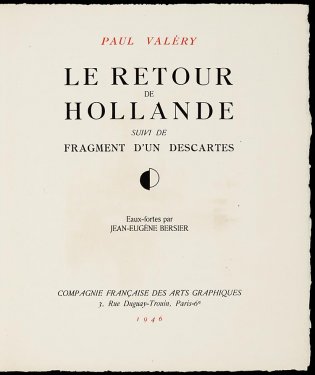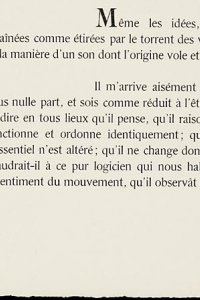Le retour de Hollande, suivi de Fragment d'un Descartes
Year: 1946
Author: Paul Valéry (1871 - 1945)
Artist: Jean Eugène Bersier (1885 - 1978)
Publisher: Compagnie française des arts graphiques
The rational art of Jean Eugène Bersier
With a cautious sense of detail Jean Eugène Bersier illustrated the well-known Dutch landscape in fifteen black-and-white etchings described by Valéry in Le retour de Hollande: mills, canals, boats, fishermen, horses and seagulls. Bersier was an authority in the field of the technique of etching. He wrote a number of manuals on the subject, including La gravure: Les procédés, l'histoire (1947). In 1928, he was co-founder of the association La Jeune Gravure Contemporaine. In his view, an etching was the result of a struggle between the intention of the artist and the unruliness of the material. That is why the artist must have a clear plan in advance: the etching is a 'reasoned' artform.
Bibliographical description
Description: Le retour de Hollande, suivi de Fragment d’un Descartes / Paul Valéry ; eaux-fortes par Jean-Eugène Bersier. – Paris : Compagnie française des arts graphiques, 1946. - 46 p. : ill. ; 26 cm
Printer: R. Girard (text); Thirot pour la Compagnie des Arts Graphiques (etchings)
Edition: 333 copies
This copy: Number 244 of 291 on pur fil Lana
Bibliography: Bénézit 2-203 ; Dugnat et Sanchez I-236 ; Saur Allgemeines Künstler-Lexikon 10-32
Shelfmark: KW KOOPM K 140
References
- Jean E. Bersier, La gravure: Les procédés, l'histoire. Paris, Berger-Levrault, 1963
- Denis Bertholet, Paul Valéry. Paris, Plon, 1995
- Paul Gifford, Paul Valéry à tous les points de vue. Paris, L'Harmattan, 2003
- William Kluback, Paul Valéry: A philosopher for philosophers, the sage. New York, Lang, 2000
- Anne Mairesse, Figures de Valéry. Paris, L'Harmattan, 2000
- Paul Valéry, De terugreis uit Holland. (Vertaling A.A.M. Stols). Maastricht, A.A.M. Stols, 1926


